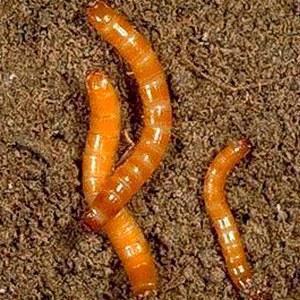Preparing the next harvest - fighting the wireworm
 Wireworms are yellowish to the touch, very tough worms up to 3 centimeters long, which cause great harm to our crops. Most of all, potato crops are susceptible to this pest. The worm itself is the larva of a beetle called the clicker.
Wireworms are yellowish to the touch, very tough worms up to 3 centimeters long, which cause great harm to our crops. Most of all, potato crops are susceptible to this pest. The worm itself is the larva of a beetle called the clicker.
Wireworms are polyphagous by nature, the most attractive delicacy for them is wheatgrass roots. Hence the conclusion that if there is wheatgrass in your garden, there will be a wireworm.
These parasites move easily in the soil. For their living, it is enough that the soil has a moisture content of 50 percent, the ambient temperature was not lower than twenty degrees. The wireworm practically does not live in dry soil, but is able to go down in search of moisture to a depth of one meter. The more moisture in the soil in your garden, the closer the worm will be to the surface. Damaging potato tubers, making passages in them, where dry or wet rot forms a breeding ground for the disease. As a result, the storage of potatoes in terms of time is significantly reduced. And the costs of your labor are not justified.
What needs to be done to prevent the multiplication of this infection:
- liming the soil - the wireworm does not like the soil with high acidity. Just do not overdo it, as an increase in acidity contributes to the appearance of another equally harmful misfortune - common scab.
- application of ammonia-containing fertilizers in soil cultivation. The toxic effect of these substances is very helpful in the fight against wireworms.
- application of baits on the crop site. To do this, we use oats, barley, corn, plants that wireworms like, which must be treated with insecticides in advance, dried, and sown in your garden, about two, three weeks before you wake up to plant potatoes. Taking care of the sowing of potatoes (loosening, hilling) the sprouted seeds of these crops, you will automatically destroy.
- the more often and more thoroughly we take care of the garden (loosen, weed out), the less the likelihood of an increase in the number of this parasite, the obligatory early dressing of the seed with systemic insecticides.
These measures, which are not laborious, but effective, will allow you to largely protect your crops from the action of the wireworm.
Video about effective wireworm control
Have a nice harvest!
Thanks to the author for the good advice. Last year, our potato crop was spoiled by wireworms. Almost every potato had through holes. Yes, wheatgrass is also present in the garden. Didn't know that wireworm and wheatgrass are interconnected. I just didn’t do, but I just can’t get rid of wheatgrass. Maybe there are some effective methods to combat this weed?
The wireworm really requires constant attention. This is the larva of the click beetle, which lives in the ground for four years, pupates on the fourth. But the first two years they are not visible, the worms are small. When there were a lot of earthworms on the site, the wireworm almost disappeared. It seems to me that while the wireworms are tiny, they serve as food for the red worms. And those appeared in abundance when I systematically began to use EM-1 Baikal preparation.And I also noticed that after the autumn sowing of phacelia, there was also a little wireworm. But maybe everything worked together, Bazudin in the hole when planting, liming, fishing with bait in the spring. But you still can't get rid of it completely. Therefore, we dig out the potatoes as early as possible, by the fall the worms begin to spoil the tubers faster. You also need to be careful when importing fertile land or humus. With them, you can deliver the pest to the site.